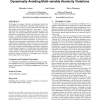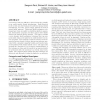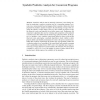184 search results - page 17 / 37 » Monitoring Atomicity in Concurrent Programs |
SIGPLAN
2008
13 years 7 months ago
2008
As memory transactions have been proposed as a language-level replacement for locks, there is growing need for well-defined semantics. In contrast to database transactions, transa...
ISCA
2010
IEEE
14 years 19 days ago
2010
IEEE
In this paper, we propose ColorSafe, an architecture that detects and dynamically avoids single- and multi-variable atomicity violation bugs. The key idea is to group related data...
AGENTS
2000
Springer
13 years 12 months ago
2000
Springer
Before the powerful agent programming paradigm can be adopted in commercial or industrial settings, a complete environment, similar to that for other programming languages, must b...
ICSE
2010
IEEE-ACM
14 years 10 days ago
2010
IEEE-ACM
Concurrency fault are difficult to find because they usually occur under specific thread interleavings. Fault-detection tools in this area find data-access patterns among threa...
FM
2009
Springer
14 years 2 months ago
2009
Springer
Abstract. Predictive analysis aims at detecting concurrency errors during runtime by monitoring a concrete execution trace of a concurrent program. In recent years, various models ...



